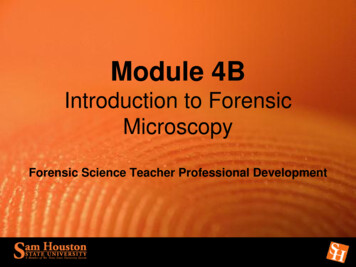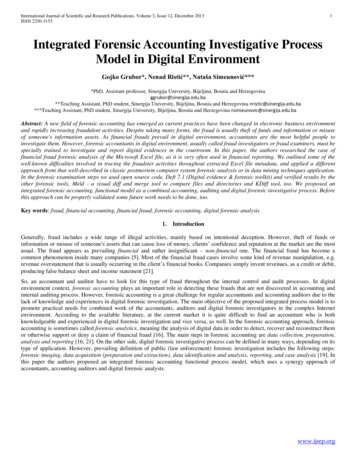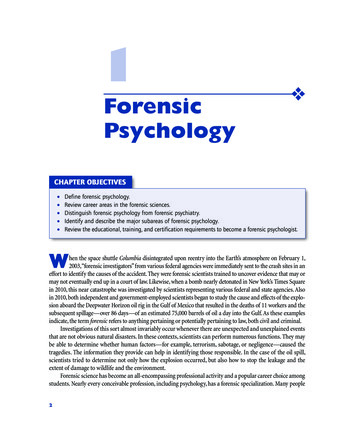
Transcription
Physics With A Purpose:Forensic Science ApplicationsKathy MirakovitsIB Physics, IB Biology & Forensic Science TeacherPortage Northern High SchoolPortage, Michigankmirakovits@gmail.comPDF of PowerPoint and Handouts Available At:www.forensicsciencewww.forensicscience-ed.com
Crime Scene Physics
Analyzing Broken Glass Broken glass analysis is forensically important tothe reconstruction of events in a criminal act Analysis can include: The sequence of the fractures – order of events The direction of the force which caused the fracture – did thebreak occur from the inside or outside The identity (type) of a small piece of glass – soda lime glass,borosilicate, tempered, or lead crystal Kathy Mirakovits, Forensic Science Educational Consulting. LLC
Force on Glass: Analyzing FracturesBullet Traveling Through Glass: Analyze Entry vs. ExitF:\Videos\bullet - slow motion animation - YouTube.flvSequence Fractures for Multiple BreaksDetermine Direction of Force3R: Radial, Right, Reverse Kathy Mirakovits, Forensic Science Educational Consulting. LLC
Projectiles & Glass:Analyzing Entryand ExitEntry is flat and smooth around edgesExit is cratered and rough around edgesProjectile Movie
Class Characteristics of Glass Class characteristics of glass are limited because glass is soinert—inert—difficult to dissolve in solvents Exception is the Inductively Coupled Plasma MassSpectrometer (ICP/MS)—(ICP/MS)—digests glass and performselemental analysis to determine chemical composition ICP/MS in few crime labs and probably no high schools Old analytical techniques—techniques—look at class characteristics: Physical appearance – size, shape, thicknessColorDensityRefractive index Kathy Mirakovits, Forensic Science Educational Consulting. LLC
Measuring The DensityOf A Small Piece of Glass1.2.3.Mass the piece of glass.Find Volume of glass.a. Tare beaker with water.b. Tie thread around glass.c. SUSPEND the glass in water.d. Take mass reading.e. Mass of water displaced Volume of water displaced Volume of piece of glass.Calculate density of the glass.Window GlassPyrex GlassLeaded Glass2.532.53-2.54 g/ml (2.5)2.292.29-2.39 g/ml (2.2)2.652.65-2.92 g/ml (2.8) Kathy Mirakovits, Forensic Science Educational Consulting. LLC
Refractive Index Refractive Index (RI) is the ratio of the velocity of light in avacuum to it’s velocity in a medium Equation:RI c/vmediumc 3 x 108 m/s As light passes from one medium to a different medium, itchanges speed, causing it to bend or refractThe straw appears bent due to refraction of light
Glass ID Using Properties of Refraction If two transparent materials havethe same RI, light will not refractas it passes from one to the other. If solid is placed in liquid withsame RI, it will disappear. Demonstrations of similar RIGhost Crystals: crosscross-linkedpolyacrylamideVegetable Oil and Pyrex Kathy Mirakovits, Forensic Science Educational Consulting. LLCSolid isvisible in air.Solid hassame RI asliquid. Startsto disappear.Solidimmersedin liquid.Not visible.
Refractive Index Determinationof a Small Glass Fragment Refractive index of small pieces of glass can be determined usingcommercially available liquids whose refractive indexes are knownABCPhoto A shows a small piece of Pyrex glass not immersed in a liquid.Photo B shows the same piece of glass immersed in water.Photo C shows the piece immersed in vegetable oil. Pyrex and vegetable oil havesimilar indices of refraction as shown by the disappearance of the glass in the oil.oil Kathy Mirakovits, Forensic Science Educational Consulting. LLC10
Refractive Index Determinationof a Small Glass FragmentGlass TypeWindow Glass (soda lime)PyrexTempered Glass (auto)Leaded Glass (29%(29%-55%)Liquid MediumWaterVegetable OilClove Oil Kathy Mirakovits, Forensic Science Educational Consulting. LLCRI1.511.471.521.571.57-1.67RI1.331.471.53
Measure the RI of Comparison Liquids Use plastic dishes filled withliquid to be tested Laser light or light box singlebeam through liquid at a givenangle (300). Trace refracted beam. Calculate RI using Snell’s Lawn1 n2(sin θ2) / sin θ1n2 1.00 (air) Kathy Mirakovits, Forensic Science Educational Consulting. LLC
Projectile Motion: Blood In Flight Blood in flight obeys laws of gravityImpact spatter due to blunt force traumaUse trigonometry to locate position of source Kathy Mirakovits, Forensic Science Educational Consulting. LLC
Analyzing the Motion of a Blood DropletθAB(width) sinBC (length) 1ABCBABDroplet’sMotion VectorθAΘΘB Kathy Mirakovits, Forensic Science Educational Consulting. LLCC
Calculating Impact Angle Impact Angle (θ(θ) (sin-1) width/length Practice Sheet. Blood Drop A: W/L 0.9cm/2cm270Blood Drop B: W/L 1.2cm/1.9cm 390Blood Drop C: W/L 0.7cm/2cm200 Kathy Mirakovits, Forensic Science Educational Consulting. LLC
Finding the Third DimensionTan(θ ) P / DP Tan(θ ) * DPBlood dropletθFrom Area of ConvergenceD Kathy Mirakovits, Forensic Science Educational Consulting. LLC
ProjectileMotion:BloodInFlightImpact Angles1. 2/524072. 1.5/4 2203. 1/3P D (Tan θ)1. 4.9 cm2002. 6.1 cm4. 2/4.5 2605. 3/63006. 2/43007. 1/41403. 5.3 cm325. 4.2 cmTan θ P/D4D (point to stain)1. 11 cm2. 15 cm4. 4.5 cm6. 5.6 cm67. 5.1 cm5Conclusion:1The source was 4.2to 6.1 cm above thePoint of Convergence3. 14.5 cm4.9.3 cm5. 7.3 cm6. 9.7 cm7. 20.6 cmPoint ofConvergence
Accident ReconstructionTo determine the speed of the vehicle—vehicle—Use coefficient offriction (drag factor) & length of skid marks. W Ek (Work Done Kinetic Energy)Energybraking—friction) Ffd Ek (Work is done by braking— µmgdmgd ½ mv2 µmgdmgd ½ mv2 v2 2µgdgdv speed (s)µ drag factor (f)s2 2fgd (d in feet, s in mi/hr, g in ft/s2) Kathy Mirakovits, Forensic Science Educational Consulting. LLC
Accident ReconstructionSimplifying the equation and dealing with units: s2 2213600secftmile 1mile x 32222fd(ft) 5280ftsec1hr5280ft s2 29.75(miles2/hr2)dfs 30 df Kathy Mirakovits, Forensic Science Educational Consulting. LLC
s 30dfAccident ReconstructionDetermining “f ”a. Drag Sled—Sled—force of friction between tire and road surface.Determine weight of drag sled. Use formula f Ff/Fgb. Test Skids. Use car to lay down skids, note speed at start of skid.Measure length of all 4 skids. Use f s2/30dActual Skida. Find dave by measuring all 4 skidmarks.b. Use the “f ” found by one or both of the methods above.c. Calculate the speed (s) going into the skid. Kathy Mirakovits, Forensic Science Educational Consulting. LLC
Test Skids Kathy Mirakovits, Forensic Science Educational Consulting. LLC
Thank You—You—Questions? Contact Information: Kathy d.com Forensic Science Workshops Summer 2012Atlanta, GAJune 1212-15Portland, ORJune 2626-29LTU (Southfield, MI) July 99-13IUPUI (Indianapolis) July 1717-20Portage, MIJuly 3030-Aug 3 Textbook? www.crcpress/com Kathy Mirakovits, Forensic Science Educational Consulting. LLC
Supplies for ActivitiesMy recommendations for supplies:1. Blood Spatter Kits from Wards Natural ScienceIntroduction to Blood Spatter Analysis: 36 V 0047Advanced Techniques in Blood Spatter Analysis. 36 V 0048Simulated Drip & Projected Blood. 37 V 5310Simulated Transfer Blood. 37V53112. Glass Analysis from Wards Natural ScienceForensic Analysis of Glass. 36 V 62403. Accident Investigation & Drag Sled. 36 V 6268 & 15 V 6268
Forensic Science Applications Kathy Mirakovits IB Physics, IB Biology & Forensic Science Teacher Portage Northern High School Portage, Michigan kmirakovits@gmail.com PDF of PowerPoint and Handouts










